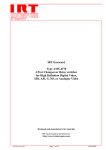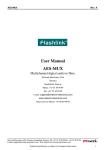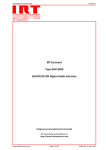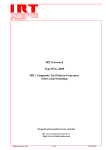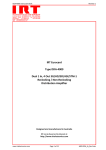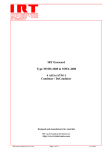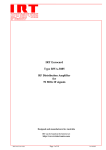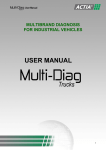Download User Manual - IRT Communications
Transcript
DDT‐4220 & DDR‐4225 Instruction Book Revision 3 I R T Electronics Pty Ltd A.B.N. 35 000 832 575 26 Hotham Parade, ARTARMON N.S.W. 2064 AUSTRALIA National: Phone: (02) 9439 3744 Fax: (02) 9439 7439 International: +61 2 9439 3744 +61 2 9439 7439 Email: [email protected] Web: www.irtelectronics.com IRT Eurocard Type DDT‐4220/DDR‐4225 270Mb/s / ASI / SDI 4 Channel Multiplexer / De‐Multiplexer Fibre Optic Link DANGER Invisible LASER radiationAvoid direct exposure to beam Peak power Wavelength 2 mW 1310/1550nm Class 1 LASER Product Designed and manufactured in Australia IRT can be found on the Internet at: http://www.irtelectronics.com www.irtelectronics.com Page 1 of 17 4220‐DDT & 4225‐DDR.ib.Rev3.doc DDT‐4220 & DDR‐4225 Instruction Book Revision 3 IRT Eurocard Type DDT‐4220/DDR‐4225 270Mb/s / ASI / SDI 4 Channel Multiplexer/De‐Multiplexer Fibre Optic Link Revision History Revision 0 1 2 3 Date 07/03/2005 23/02/2006 08/09/2006 03/06/2010 www.irtelectronics.com By AL AL AL AL Change Description Original Issue. Block diagram corrected. Jitter diagram added. Jitter mask corrected. Page 2 of 17 Applicable to: S/N: >0410001 S/N: >0410001 S/N: >0410001 S/N: >0410001 4220‐DDT & 4225‐DDR.ib.Rev3.doc DDT‐4220 & DDR‐4225 Instruction Book Revision 3 IRT Eurocard Type DDT‐4220/DDR‐4225 270Mb/s / ASI / SDI 4 Channel Multiplexer/De‐Multiplexer Fibre Optic Link Instruction Book Table of Contents Section Page Revision History Operational Safety General Description Typical Jitter Characteristics Technical Specifications Configuration Operation Alarms & Indicators Installation SNMP DDT‐4220 & DDR‐4225 SNMP Functions Installation 270Mb/s / ASI / SDI Inputs and Outputs Fibre Optics Connection SMU‐4000 Installation Figure 1: SMU‐4000 module Alarm Connections RS‐422 Connection The RS‐422 standard Front and rear layouts Maintenance & Storage Warranty & Service Equipment return 2 4 5 6 7 8 9 9 10 10 12 13 13 13 14 14 14 15 15 16 17 17 17 This instruction book applies to units later than S/N: 0410001. www.irtelectronics.com Page 3 of 17 4220‐DDT & 4225‐DDR.ib.Rev3.doc DDT‐4220 & DDR‐4225 Instruction Book Revision 3 Operational Safety: WARNING Operation of electronic equipment involves the use of voltages and currents that may be dangerous to human life. Note that under certain conditions dangerous potentials may exist in some circuits when power controls are in the OFF position. Maintenance personnel should observe all safety regulations. Do not make any adjustments inside equipment with power ON unless proper precautions are observed. All internal adjustments should only be made by suitably qualified personnel. All operational adjustments are available externally without the need for removing covers or use of extender cards. Optical Safety The light emitted from the LASER diode used in this system is invisible and may be harmful to the human eye. Avoid looking directly into the fibre optic cable or connectors or into the collimated beam along their axis when the device is in operation. Operating the LASER diode outside of its maximum ratings may cause device failure or a safety hazard. DANGER Invisible LASER radiationAvoid direct exposure to beam Peak power Wavelength 2 mW 1310/1550nm Class 1 LASER Product www.irtelectronics.com Page 4 of 17 4220‐DDT & 4225‐DDR.ib.Rev3.doc DDT‐4220 & DDR‐4225 Instruction Book Revision 3 IRT Eurocard Type DDT‐4220/DDR‐4225 270Mb/s / ASI / SDI 4 Channel Multiplexer/De‐Multiplexer Fibre Optic Link General Description Any 270 Mb/s ±100 ppm Optical Path Loss 4dB – 32dB DDT-4220 1310 nm (1550 nm) SNMP DDR-4225 SNMP RS 422 < 9600 baud RS 422 < 9600 baud The DDT‐4220 accepts up to four 270 Mb/s input signals which may be ASI, SDI or a mixture of each type. The signals need not be phase or frequency synchronous. The signals are time division multiplexed into a single 1.302 Gb/s stream and transmitted via single mode fibre to the DDR‐4225 receiver, which performs the reverse operation and restores correct 270 Mb/s timing. In addition to the four 270 Mb/s channels, a single RS422 channel is included for transmission of auxiliary data at rates of up to 9600 baud. The DDT‐4220/DDR‐4225 optical system is primarily designed for use with a 9/125μm single mode fibre and will allow an optical path loss from 4dB up to 32dB. An optional Simple Network Management Protocol (SNMP) plug‐in module is available for remote monitoring of input and output status and alarm states. The DDT‐4220 transmitter comes available with a choice of standard 1310nm laser (order code DDT‐4220/1300) or a DFB 1550nm laser (order code DDT‐4220/1550). Other wavelengths are available on request. The DDR‐4225 receiver is the same regardless of transmitter wavelength. The modules are designed to fit IRT’s standard Eurocard frames as well as IRT’s 4000 series frame for use with IRT’s SNMP system and may be used alongside any other of IRT’s analogue or digital Eurocards. Standard features: • • • • • 270 Mb/s type signals, such as ASI and SDI, capability. Automatic cable equalisation for up to 200m on each input. Maximum optical path loss of 32dB. External urgent and non‐urgent alarms for system monitoring. Optional plug‐in SNMP monitoring module. Applications: • • • Multichannel digital with data on a single fibre. Upgrade capacity of existing fibre. Maintain timing between related signals by ensuring same path transmission delay. www.irtelectronics.com Page 5 of 17 4220‐DDT & 4225‐DDR.ib.Rev3.doc DDT‐4220 & DDR‐4225 Instruction Book Revision 3 Typical Jitter Characteristics The following table shows typical output jitter versus input jitter characteristics. Note how output jitter is appreciably reduced. Measurement corresponds to SMPTE S259M‐2006. Measurement in accordance with RP 184. Input signal 75% colour bars. 3.5 3 2.5 UI O/P Jitter SMPTE Mask Input Jitter 2 1.5 1 0.5 5MHz 2MHz 1MHz 800kHz 500kHz 400kHz 300kHz 250kHz 50kHz 10kHz 1kHz 100Hz 0.2UI 10Hz 0 Frequency www.irtelectronics.com Page 6 of 17 4220‐DDT & 4225‐DDR.ib.Rev3.doc DDT‐4220 & DDR‐4225 Instruction Book Revision 3 Technical Specifications Types DDT‐4220/DDR‐4225 DDT‐4220: Inputs: Type EQ Format Connectors 4 x 270 Mb/s ±100 ppm, 0.8 Vp‐p./ASI/SDI. automatic for up to 250 m of Belden 8281 or equivalent cable. synchronous or asynchronous. BNC 75Ω RS422: Type Connectors 1 x 9600 baud, synchronous or asynchronous. HE 14/8 / matches DN 9. Outputs: Type Power level Connector 1 x 1.302 Gb/s optical (wavelength dependent on unit ordered). 0 dBm (1 mW) ± 1 dB. SC/PC. Alarms: Urgent Non‐urgent N/C relay for loss of power, TX lock error or LASER fail. N/C relay if no channels are present. DDR‐4225: Inputs: Type Power Level* Connector 1 x 1.302 Gb/s optical. ‐4 dBm to > ‐ 32 dBm. SC/PC. Outputs: Type Format Connectors 4 x 270 Mb/s ±100 ppm, 0.8 Vp‐p./ASI/SDI. synchronous or asynchronous. BNC 75Ω RS422: Type Connectors 1 x 9600 baud, synchronous or asynchronous. HE 14/8 / matches DN 9. Alarms: Urgent Non‐urgent N/C relay for loss of power, RX lock error or optical input fail. N/C relay if no channels are present. Optical: Optical path loss* Optical fibre Optical wavelength 4 dB to 32 dB. Designed for use with 9/125μm single mode fibre. see ordering information. Power requirement: Voltage Consumption 28 Vac CT (14‐0‐14) or ±16 Vdc. DDT‐4220 <10 VA, DDR‐4225 <12.5 VA. Other: Temperature range Ordering Information Mechanical Finish: Front panel Rear assembly Dimensions Supplied accessories Optional Accessories 0 ‐ 50° C ambient DDT‐4220/1300 standard 1310 nm model; DDT‐4220/1550 DFB 1550nm model. Suitable for mounting in IRT 19" rack chassis with all connections at the rear. Grey background, silk‐screened black lettering & red IRT logo. Detachable silk‐screened PCB with direct mount connectors to Eurocard and external signals. 6 HP x 3 U x 220 mm IRT Eurocard. Rear connector assembly including matching connector for switcher control. SNMP plug‐in module for use with 4000 series frame fitted with SNMP “Agent”. * Note: Optical attenuator must be used for DDR‐4225 when optical path loss is less than 4 dB. Due to our policy of continuing development, these specifications are subject to change without notice. www.irtelectronics.com Page 7 of 17 4220‐DDT & 4225‐DDR.ib.Rev3.doc DDT‐4220 & DDR‐4225 Instruction Book Revision 3 Configuration Other than the following link settings, there are no user configurable settings. All other potentiometer and link settings are factory set and should not be moved. User link settings: DDT‐4220: LK10 DDR‐4225: LK10 www.irtelectronics.com IN OUT RS422 terminated in 220Ω RS422 unterminated. IN OUT RS422 terminated in 220Ω, RS422 unterminated. Page 8 of 17 4220‐DDT & 4225‐DDR.ib.Rev3.doc DDT‐4220 & DDR‐4225 Instruction Book Revision 3 Operation Up to four ASI, SDI, or a combination both, are connected to the input 75 Ω BNC connectors on the rear assembly of the DDT‐4220 four channel mux transmitter. Each of the inputs must be 270 Mb/s. These input signals do not need to be synchronous with each other. Unused inputs should be terminated with 75 Ω terminations so as to suppress any spurious noise that may be generated on an unterminated input. Multiplexed signal is then optically transmitted at 1.302 Gb/s . The DDR‐4225 de‐mux receiver detects the optical signal and then de‐multiplexes it. Outputs, in the same order to the inputs, appear on the 75 Ω BNC connectors on the rear connector panel. As well as 270Mb/s types of signal inputs, such as ASI or SDI, a dedicated RS‐422 port is provided on each of the units for transmission with the other input signals. Alarms & Indicators: DDT‐4220: Urgent Alarm relay contact closure for loss of power, Tx lock error or laser fail; Non‐urgent Alarm contact closure if no channels are present; Channel 1 presence indicator (green LED); Channel 2 presence indicator (green LED); Channel 3 presence indicator (green LED); Channel 4 presence indicator (green LED); Tx lock error or laser fail (red LED); DC power (green LED); DDR‐4225: Urgent Alarm relay contact closure for loss of power, Rx lock error or loss of optical input; Non‐urgent Alarm relay contact closure if no channels are present; Channel 1 presence indicator (green LED); Channel 2 presence indicator (green LED); Channel 3 presence indicator (green LED); Channel 4 presence indicator (green LED); Rx lock error or loss of optical input (red LED); DC power (green LED); www.irtelectronics.com Page 9 of 17 4220‐DDT & 4225‐DDR.ib.Rev3.doc DDT‐4220 & DDR‐4225 Instruction Book Revision 3 SNMP What Is It? SNMP stands for Simple Network Management Protocol. It is an application layer protocol for managing IP (Internet Protocol) based systems. SNMP enables system administrators to manage system performance, and to find and solve system problems. SNMP runs over UDP (User Datagram Protocol), which in turn runs over IP. Three types of SNMP exist: SNMP version 1 (SNMPv1), SNMP version 2 (SNMPv2) and SNMP version 3 (SNMPv3). It is not the intention here to discuss the differences between various versions, only to bring attention to the fact that IRT Electronics modules, fitted with SNMP capability, use SNMPv1. An SNMP managed network consists of three key components: Network Management Systems (NMS), agents, and managed devices. An NMS is the console through which the network administrator performs network management functions, such as monitoring status (e.g. alarm states) and remote controlling, of a set of managed devices. One or more NMSs must exist on any managed network. Generally the NMS is a computer running third party SNMP control software. There are a number of third party SNMP software applications currently available on the market. An NMS polls, or communicates with, an agent. An agent is a network management software module that resides in a managed device. An agent has local knowledge of management information and translates that information into a form compatible with SNMP. The agent, therefore, acts as an interface between the NMS and the managed devices. The NMS sends a request message, and control commands for the managed devices, to the agent, which in turn sends a response message, containing information about the managed devices, back to the NMS. A managed device contains an SNMP agent and resides on a managed network. Managed devices collect and store management information and make this information available to NMSs using SNMP. Managed device agent variables are organised in a tree structure known as a Management Information Base (MIB). Within the MIB are parameters pertaining to the managed device. An Object Identifier (OID) number within the MIB defines the managed device type. This is a unique number specific to the model of managed device. Other information relating to the device is also stored, information such as alarm states, controllable settings, etc. The MIB tree is organised in such a way that there will be no two MIB files with conflicting placements. Normally an NMS polls an agent for information relating to the MIB in a managed device to be sent back to the NMS. When certain conditions are met within the MIB, such as major alarm conditions, for example, the agent automatically sends what is known as a trap to the NMS without any prompting from the NMS. This allows automatic notification of a predetermined event. SNMP Block Diagram SNMP Agent NMS MIB SNMP Agent MIB SNMP Agent MIB SNMP Agent Protocol Engine IP Network SNMP Agent Protocol Engine NMS SNMP Agent Protocol Engine www.irtelectronics.com Page 10 of 17 4220‐DDT & 4225‐DDR.ib.Rev3.doc DDT‐4220 & DDR‐4225 Instruction Book Revision 3 SNMP with IRT Products IRT Electronics currently employs SNMPv1 with its 4000 series frame. The frame acts as an agent when fitted with a CDM‐4000 module. This module has its own designated slot next to the power supply so as to not affect the number of modules that the frame will take. Communication between the NMS, the frame and its loaded modules are via this CDM‐4000 module. Note that the NMS software is third party and not supplied by IRT Electronics. Ethernet connection for SNMP operation is via an RJ45 connector on the rear of the frame, below the mains inlet. Ethernet rate runs at either 10 baseT or 100 baseT. Frame parameters, such as Name, Address and Location, are set via an RS232 interface, a D9 connector on the rear of the frame below the mains inlet. A software terminal emulator, such as Tera Term or HyperTerminal, is used for setting and reading the parameters of the frame. IRT modules that are SNMP compatible need a plug‐in SMU‐4000 module with a program relevant to the module that it is plugged into. Depending on the module, besides the module identification, parameters such as alarm states, inputs and controls etc. are communicated to the CDM‐4000 agent via a data bus on the rear of the frame. Thus the CDM‐4000 collects information on what is loaded within the frame, what positions they occupy, and their current status for communication to the NMS when the NMS sends a request for information. In the event of a major alarm from any of the SNMP compatible modules, or power supplies, a trap is automatically sent by the CDM‐4000 agent to the NMS without any prompting by the NMS. This alerts the operator to any fault conditions that may exist that need immediate attention. 110/240 V 50/60 Hz 0.7 A (max.) FRU-4000 FRAME FUSES 220/240 Vac 500 mA S.B. 110/120 Vac 1A S.B. RS232 Alarm Ethernet + 48Vdc AS3260 approval no.: CS6346N Ass. no.: 804692 IRT SNMP Connections IRT modules fitted with SMU-4000 NMS Network Ethernet Cable CDM-4000 PSU’s IRT 4000 Series Frame Ethernet Cable IRT modules fitted with SMU-4000 CDM-4000 PSU’s IRT 4000 Series Frame Ethernet Cable IRT 4000 Series SNMP Setup www.irtelectronics.com Page 11 of 17 4220‐DDT & 4225‐DDR.ib.Rev3.doc DDT‐4220 & DDR‐4225 Instruction Book Revision 3 DDT‐4220 & DDR‐4225 SNMP Functions: With the DDT‐4220/DDR‐4225 fitted with the optional plug‐in SMU‐4000 SNMP module, programmed with firmware to suit, and installed in an IRT 4000 series frame with SNMP capability, the DDT‐4220/DDR‐4225 can be interrogated by an SNMP Network Management System (NMS). The following SNMP functions are capable of being monitored by an NMS: The current state of the “Urgent” and “Non‐urgent” alarms; Information about each of the 4 channels, whether ASI or SDI; An indication that the laser is operating (for the DDT‐4220 only); An indication that there is an optical input (for the DDR‐4225 only); The software version of the FPGA; Whether “Trap” function is enabled; Trap automatically sent, if enabled, on “Urgent” alarm (except loss of power); Trap automatically sent, if enabled, if “Urgent” alarm clears; and Unit reset control. www.irtelectronics.com Page 12 of 17 4220‐DDT & 4225‐DDR.ib.Rev3.doc DDT‐4220 & DDR‐4225 Instruction Book Revision 3 Installation Pre‐installation: Handling: This equipment may contain or be connected to static sensitive devices and proper static free handling precautions should be observed. Where individual circuit cards are stored, they should be placed in antistatic bags. Proper antistatic procedures should be followed when inserting or removing cards from these bags. Power: AC mains supply: Ensure that operating voltage of unit and local supply voltage match and that correct rating fuse is installed for local supply. DC supply: Ensure that the correct polarity is observed and that DC supply voltage is maintained within the operating range specified. Earthing: The earth path is dependent on the type of frame selected. In every case particular care should be taken to ensure that the frame is connected to earth for safety reasons. See frame manual for details. Signal earth: For safety reasons a connection is made between signal earth and chassis earth. No attempt should be made to break this connection. Installation in frame or chassis: See details in separate manual for selected frame type. 270Mb/s / ASI / SDI Inputs and Outputs: Up to four 270Mb/s type of signals, such as ASI, SDI, or a combination of both, are fed into 75 Ω BNC connectors on the rear connector panel of the DDT‐4220. Unused inputs are best terminated with a 75 Ω termination to avoid spurious noise being sent to the receiver where the front panel LEDs could illuminate and give the false impression that there is a signal on that line. The corresponding outputs are by 75 Ω BNC connectors on the DDR‐4225 rear connector panel. Output numbers on the DDR‐4225 correspond to the input numbers on the DDT‐4220. There is no need to terminate the unused channel outputs on the DDR‐4225. Fibre Optic Connection: Warning Optical Connections The optical connectors on the DDT‐4220 & DDR‐4225 are attached to the main module PCB, NOT the rear connector assembly. When installing the optical fibre sufficient slack should be allowed for the module to be withdrawn with the optical fibre attached until the connector is clear of the frame and can be disconnected. If this is not done, the module will not be able to be removed without first disconnecting the optical fibre at the rear. Attempting to remove the module without first disconnecting the fibre may result in damage to the fibre and / or the module. www.irtelectronics.com Page 13 of 17 4220‐DDT & 4225‐DDR.ib.Rev3.doc DDT‐4220 & DDR‐4225 Instruction Book Revision 3 SMU‐4000 Installation The SMU‐4000 plug‐in SNMP management controller module can only be fitted to IRT’s 4000 series modules that are capable of being SNMP upgradeable. To determine whether a module is SNMP upgradeable, a square section on the main PCB is silk screened and fitted with three multipin sockets – as shown below: 1J1 1J3 1J2 This is where the SMU‐4000 plug‐in SNMP management controller module is fitted. The three sets of multipins on the underside of the SMU‐4000 line up with the three sets of multipin sockets on the main PCB module. Align all pins and then gently press the SMU‐4000 all the way down into place. If the SMU‐4000 is not already programmed with the correct firmware to match the module that it is being plugged into, it then needs to be programmed via the pins on the topside of the SMU‐4000. Note that installation will generally be done by IRT Electronics at the time of ordering. Note also that an SMU‐4000 will only be functionally operational when the main module that it is plugged into is fitted into an IRT 4000 series frame fitted with a CDM‐4000 SNMP agent and being interrogated by a suitable Network Management System. Figure 1: SMU-4000 module Alarm Connections: Urgent and non‐urgent alarm outputs are via separate two‐pin 0.1” headers. Alarm condition is when there is a short between these two pins. For the DDT‐4220, an urgent alarm corresponds to either a loss of power loss of power, TX lock error or LASER fail, whilst a non‐urgent alarm corresponds to when no channels are present. For the DDR‐4225, an urgent alarm corresponds to either a loss of power, RX lock error or optical input fail, whilst a non‐urgent alarm corresponds to when no channels are present. www.irtelectronics.com Page 14 of 17 4220‐DDT & 4225‐DDR.ib.Rev3.doc DDT‐4220 & DDR‐4225 Instruction Book Revision 3 RS‐422 Connection: P2 1B 1A 4B 4A For connections to the RS‐422 line, wire pins from P2 to a DB9 Female connector as follows: PL4 2A 2B 3A 3B 4A 4B DB9F 2 7 3 8 4 Ground 6 Ground The RS‐422 Standard The RS‐422 standard introduced in the early 1970s defines a balanced (or differential) data communications interface using two separate wires for each signal. Due to the high noise immunity of the RS‐422 standard, high data speeds and long distances can be achieved. The RS‐422 specification allows reliable serial data communications for: • Distances up to 1200 metres • Data rates of up to 10 Mb/s Only one line driver is allowed on a line, and up to ten line receivers can be driven by it. Figure 1.1 illustrates RS‐422. RS-422 Transmitter Line Driver A(+) Balanced Line with Differential Voltages (-5V to +5V) RS-422 Receiver Line Receiver A(+) Up to 1200 metres B(-) B(-) Com Com 1 2 10 9 RS-422 Receivers (up to 10 devices) Figure 1.1: RS-422 Connection (Ref: IDC Engineers Pocket Guide) www.irtelectronics.com Page 15 of 17 4220‐DDT & 4225‐DDR.ib.Rev3.doc DDT‐4220 & DDR‐4225 Instruction Book Revision 3 Front & rear panel connector diagrams The following front panel and rear assembly drawings are not to scale and are intended to show connection order and approximate layout only. DD T- 4 2 2 0 DD R- 4 2 2 5 ASI/SDI MUX ASI/SDI DEMUX I/P 1 O/P 1 CH1 CH1 CH2 CH2 CH3 CH3 I/P 2 CH4 O/P 2 CH4 RECEIVE FAIL O/P 3 NON-URGENT URGENT I/P 3 NON-URGENT URGENT LASER FAIL I/P 4 DC O/P 4 DC P2 CAUTION Direct connections to module N140 www.irtelectronics.com P2 CAUTION Direct connections to module N140 Page 16 of 17 4220‐DDT & 4225‐DDR.ib.Rev3.doc DDT‐4220 & DDR‐4225 Instruction Book Revision 3 Maintenance & Storage Maintenance: No regular maintenance is required. Care however should be taken to ensure that all connectors are kept clean and free from contamination of any kind. This is especially important in fibre optic equipment where cleanliness of optical connections is critical to performance. Storage: If the equipment is not to be used for an extended period, it is recommended the whole unit be placed in a sealed plastic bag to prevent dust contamination. In areas of high humidity a suitably sized bag of silica gel should be included to deter corrosion. Where individual circuit cards are stored, they should be placed in antistatic bags. Proper antistatic procedures should be followed when inserting or removing cards from these bags. Warranty & service Equipment is covered by a limited warranty period of three years from date of first delivery unless contrary conditions apply under a particular contract of supply. For situations when “No Fault Found” for repairs, a minimum charge of 1 hour’s labour, at IRT’s current labour charge rate, will apply, whether the equipment is within the warranty period or not. Equipment warranty is limited to faults attributable to defects in original design or manufacture. Warranty on components shall be extended by IRT only to the extent obtainable from the component supplier. Equipment return: Before arranging service, ensure that the fault is in the unit to be serviced and not in associated equipment. If possible, confirm this by substitution. Before returning equipment contact should be made with IRT or your local agent to determine whether the equipment can be serviced in the field or should be returned for repair. The equipment should be properly packed for return observing antistatic procedures. The following information should accompany the unit to be returned: 1. 2. 3. 4. 5. 6. 7. A fault report should be included indicating the nature of the fault The operating conditions under which the fault initially occurred. Any additional information, which may be of assistance in fault location and remedy. A contact name and telephone and fax numbers. Details of payment method for items not covered by warranty. Full return address. For situations when “No Fault Found” for repairs, a minimum charge of 1 hour’s labour will apply, whether the equipment is within the warranty period or not. Contact IRT for current hourly rate. Please note that all freight charges are the responsibility of the customer. The equipment should be returned to the agent who originally supplied the equipment or, where this is not possible, to IRT direct as follows. Equipment Service IRT Electronics Pty Ltd 26 Hotham Parade ARTARMON N.S.W. 2064 AUSTRALIA Phone: Email: www.irtelectronics.com 61 2 9439 3744 [email protected] Page 17 of 17 Fax: 61 2 9439 7439 4220‐DDT & 4225‐DDR.ib.Rev3.doc





















